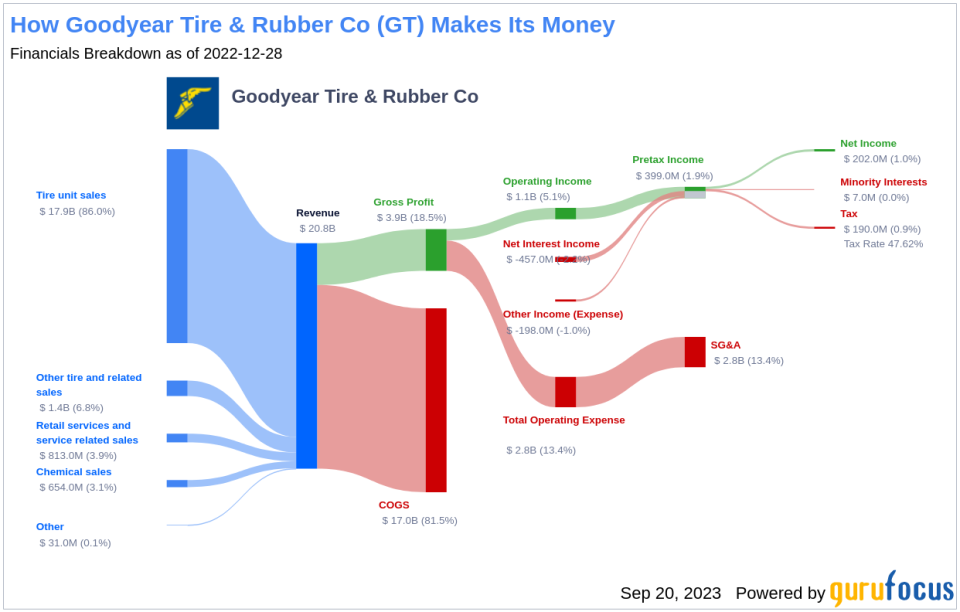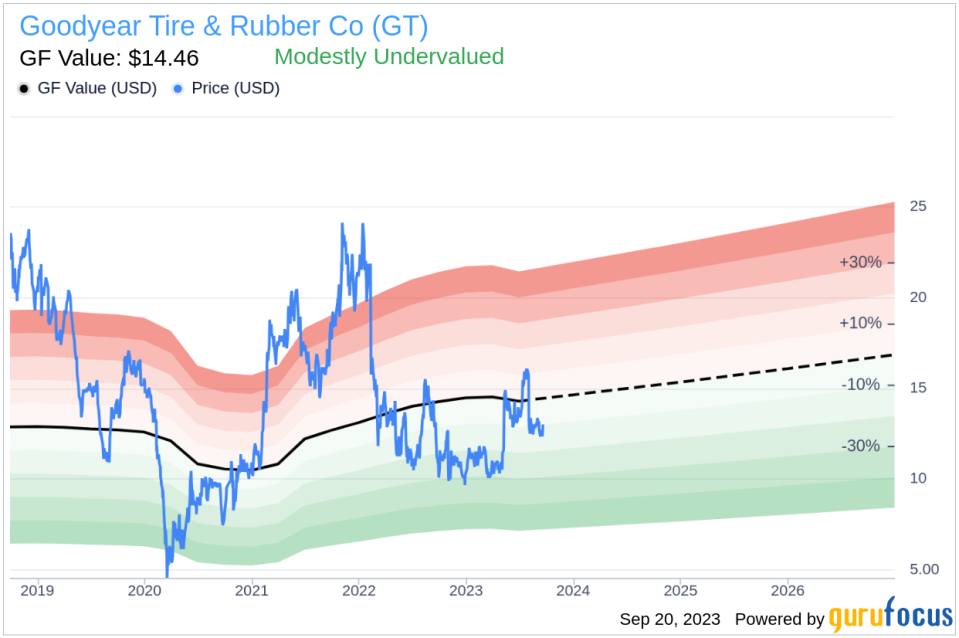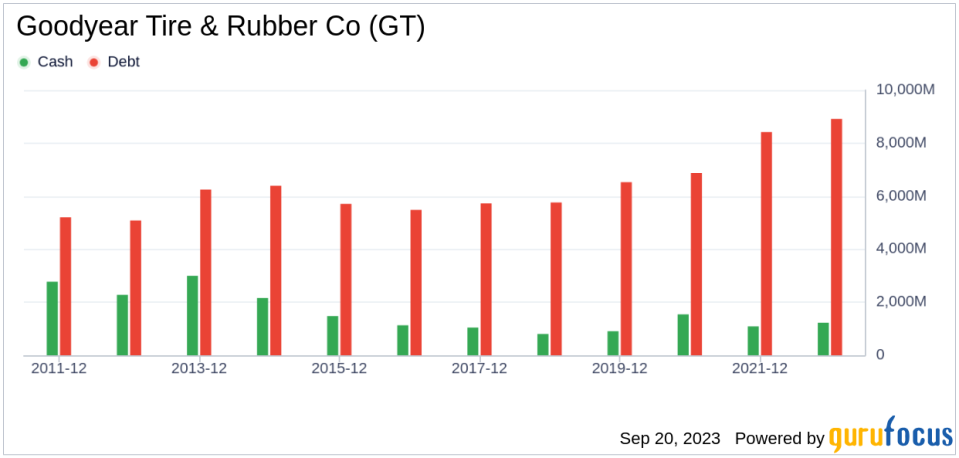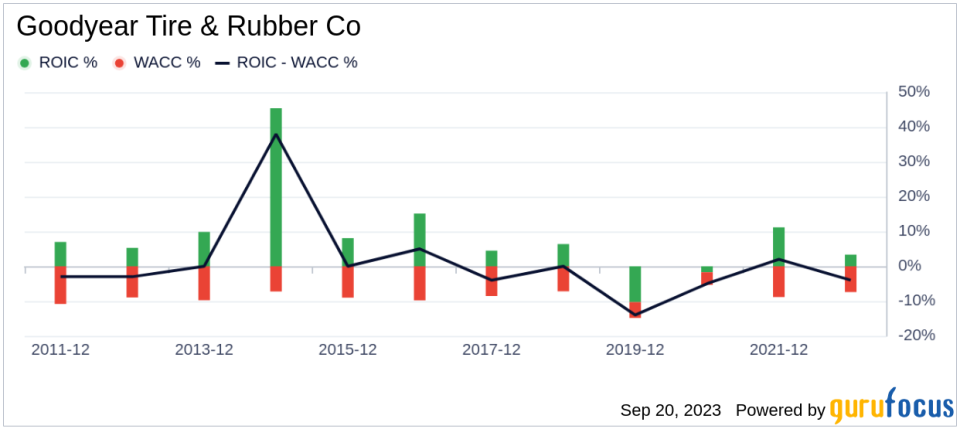Goodyear Tire & Rubber Co (NASDAQ:GT) ended the trading day with a 5% gain, despite a 4.27% loss over the past three months. The company reported a Loss Per Share of 1.29. Is the stock modestly undervalued considering these figures? This article aims to answer that question through a detailed valuation analysis. Read on for an in-depth look at Goodyear Tire & Rubber Co’s financial health and intrinsic value.
Company Overview
Goodyear Tire & Rubber Co manufactures and sells a variety of rubber tires under the Goodyear brand name. The firm’s tires are used for automobiles, trucks, buses, aircraft, motorcycles, mining equipment, farm equipment, and industrial equipment. The company operates its business through three operating segments representing its regional tire businesses: Americas; Europe, the Middle East, and Africa (EMEA); and the Asia Pacific. With a current stock price of $13.03, how does this compare to its intrinsic value?
Understanding GF Value
The GF Value is a proprietary measure of a stock’s intrinsic value, calculated based on historical trading multiples, a GuruFocus adjustment factor based on past performance and growth, and future business performance estimates. The GF Value Line provides an overview of the fair value that the stock should ideally be trading at. If the stock price is significantly above the GF Value Line, it is overvalued and its future return is likely to be poor. On the other hand, if it is significantly below the GF Value Line, its future return will likely be higher.
According to GuruFocus’ valuation method, Goodyear Tire & Rubber Co (NASDAQ:GT) appears to be modestly undervalued. The GF Value estimates the stock’s fair value based on historical multiples, an internal adjustment based on the company’s past business growth, and analyst estimates of future business performance. At its current price of $13.03 per share, Goodyear Tire & Rubber Co stock shows every sign of being modestly undervalued. As a result, the long-term return of its stock is likely to be higher than its business growth.
Link: These companies may deliver higher future returns at reduced risk.
Financial Strength Analysis
Investing in companies with poor financial strength carries a higher risk of permanent loss of capital. Thus, it’s important to carefully review the financial strength of a company before deciding whether to buy its stock. Looking at the cash-to-debt ratio and interest coverage is a great starting point for understanding the financial strength of a company. Goodyear Tire & Rubber Co has a cash-to-debt ratio of 0.11, which is worse than 84.41% of 1225 companies in the Vehicles & Parts industry. GuruFocus ranks the overall financial strength of Goodyear Tire & Rubber Co at 4 out of 10, indicating that the financial strength of Goodyear Tire & Rubber Co is poor.
Profitability and Growth
Investing in profitable companies carries less risk, especially in companies that have demonstrated consistent profitability over the long term. Typically, a company with high profit margins offers better performance potential than a company with low profit margins. Goodyear Tire & Rubber Co has been profitable 8 years over the past 10 years. During the past 12 months, the company had revenues of $20.50 billion and a Loss Per Share of $1.29. Its operating margin of 2.91% is worse than 64.3% of 1252 companies in the Vehicles & Parts industry. Overall, GuruFocus ranks Goodyear Tire & Rubber Co’s profitability as fair.
One of the most important factors in the valuation of a company is growth. Long-term stock performance is closely correlated with growth, according to GuruFocus research. Companies that grow faster create more value for shareholders, especially if that growth is profitable. The average annual revenue growth of Goodyear Tire & Rubber Co is 4.8%, which ranks worse than 53.66% of 1202 companies in the Vehicles & Parts industry. The 3-year average EBITDA growth is 4%, which ranks worse than 54.83% of 1076 companies in the Vehicles & Parts industry.
ROIC vs WACC
Another method of determining the profitability of a company is to compare its return on invested capital to the weighted average cost of capital. Return on invested capital (ROIC) measures how well a company generates cash flow relative to the capital it has invested in its business. The weighted average cost of capital (WACC) is the rate that a company is expected to pay on average to all its security holders to finance its assets. When the ROIC is higher than the WACC, it implies the company is creating value for shareholders. For the past 12 months, Goodyear Tire & Rubber Co’s return on invested capital is 4.27, and its cost of capital is 7.58.
Conclusion
In summary, the stock of Goodyear Tire & Rubber Co (NASDAQ:GT) shows every sign of being modestly undervalued. The company’s financial condition is poor and its profitability is fair. Its growth ranks worse than 54.83% of 1076 companies in the Vehicles & Parts industry. To learn more about Goodyear Tire & Rubber Co stock, you can check out its 30-Year Financials here.
To find out the high-quality companies that may deliver above-average returns, please check out GuruFocus High Quality Low Capex Screener.
This article first appeared on GuruFocus.



